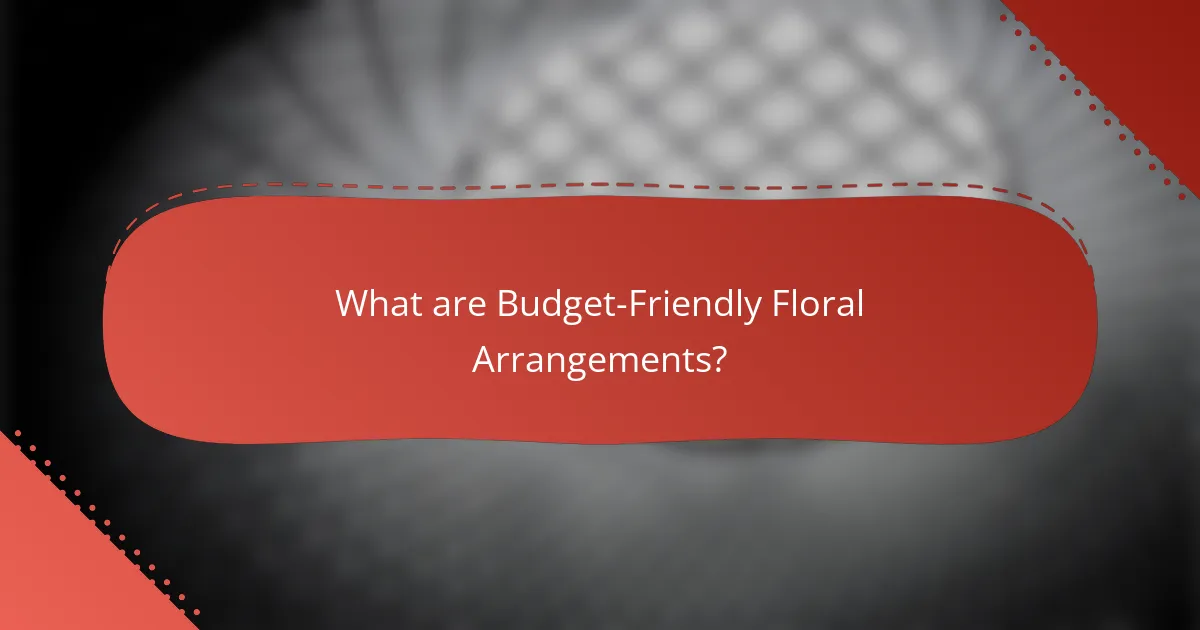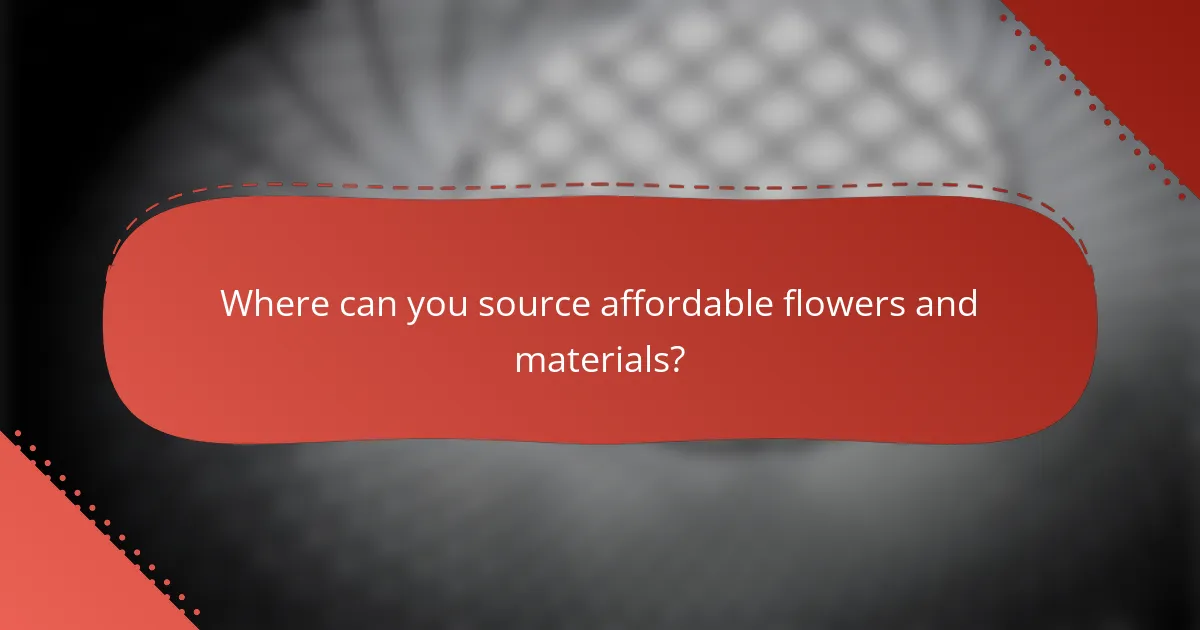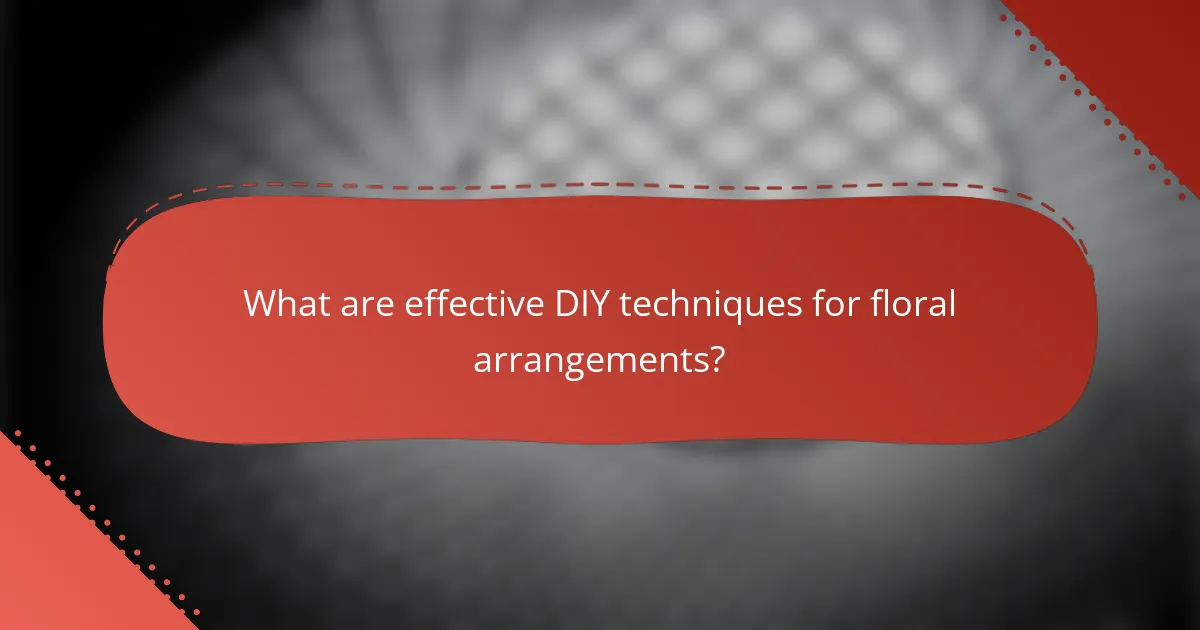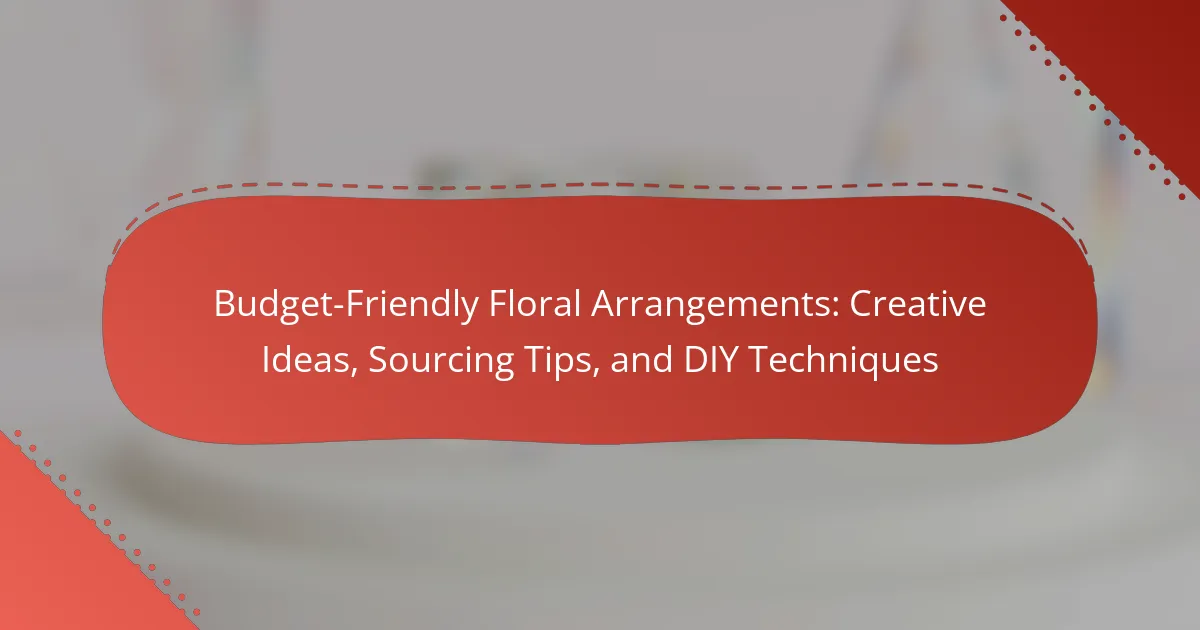
What are Budget-Friendly Floral Arrangements?
Budget-friendly floral arrangements are cost-effective designs made using affordable flowers and materials. These arrangements focus on maximizing visual appeal while minimizing expenses. Common techniques include using seasonal blooms, foraged greenery, and repurposed containers. DIY methods often involve simple arrangements that require minimal supplies. Research indicates that using local flowers can reduce costs significantly. Additionally, online resources provide tutorials for creating stunning arrangements on a budget.
How can floral arrangements be budget-friendly?
Floral arrangements can be budget-friendly by choosing seasonal flowers. Seasonal flowers are often less expensive due to their availability. Utilizing local blooms can also reduce costs significantly. Purchasing flowers in bulk from wholesalers can lead to substantial savings. Creating arrangements yourself eliminates labor costs associated with professional florists. Repurposing flowers from previous events or using greenery can enhance arrangements without added expense. Additionally, opting for smaller arrangements can minimize material costs while still achieving aesthetic appeal. These strategies collectively contribute to a more economical approach to floral design.
What types of flowers are cost-effective for arrangements?
Cost-effective flowers for arrangements include carnations, chrysanthemums, and daisies. Carnations are affordable and available in various colors. They can last up to two weeks, making them a practical choice. Chrysanthemums are also budget-friendly and come in diverse shapes and sizes. They are known for their longevity and vibrant hues. Daisies are simple yet charming, often found at low prices. Their bright appearance adds cheer to any arrangement. These flowers are widely available at local markets and grocery stores, further reducing costs.
How does seasonal availability affect budget-friendly options?
Seasonal availability significantly impacts budget-friendly options for floral arrangements. Flowers that are in season are typically more affordable due to higher supply and lower transportation costs. For example, peonies are generally less expensive in late spring when they are abundant. Conversely, out-of-season flowers often require imports, increasing their prices.
Using seasonal blooms allows for creative arrangements that are both cost-effective and visually appealing. According to the Society of American Florists, utilizing local and seasonal flowers can reduce costs by up to 30%. This approach not only supports local growers but also ensures fresher products. Therefore, selecting flowers based on seasonal availability is a practical strategy for creating budget-friendly floral arrangements.
Why choose DIY floral arrangements?
DIY floral arrangements offer cost savings and creative control. Individuals can customize designs to fit personal styles and preferences. This hands-on approach allows for selecting specific flowers and colors. According to a study by the American Society of Floral Designers, DIY arrangements can save up to 50% compared to professionally made ones. Engaging in this activity also provides a sense of accomplishment and can be a fun, therapeutic experience. Additionally, DIY arrangements enable the use of seasonal flowers, enhancing freshness and sustainability.
What skills are needed for creating DIY floral arrangements?
Creating DIY floral arrangements requires several key skills. First, an understanding of floral design principles is essential. This includes knowledge of color theory, balance, and proportion. Second, basic knowledge of flower types and their care is important. Knowing which flowers complement each other enhances the arrangement’s aesthetic. Third, cutting and arranging techniques are crucial. Properly trimming stems and arranging flowers can impact the overall look. Fourth, creativity plays a significant role. Unique designs often stem from innovative ideas and personal style. Finally, patience and attention to detail are necessary. These traits help ensure that each arrangement is crafted thoughtfully and carefully.
How can DIY arrangements save money compared to store-bought?
DIY arrangements save money compared to store-bought options by eliminating labor and markup costs. Store-bought floral arrangements often include fees for design, packaging, and transportation. DIY allows individuals to choose their own materials at lower prices. For example, buying bulk flowers can reduce costs significantly. Additionally, DIY arrangements enable customization without premium pricing. According to a study from the University of Florida, creating arrangements at home can save up to 50% compared to retail prices. This cost-effectiveness makes DIY a popular choice for budget-conscious consumers.
What are some creative ideas for budget-friendly floral arrangements?
Use seasonal flowers for budget-friendly arrangements. Seasonal blooms are often more affordable and fresher. Consider wildflowers or local varieties for unique touches. Incorporate greenery from your garden to enhance arrangements at no cost. Recycle glass jars or bottles as vases for a rustic look. Use simple designs to highlight the beauty of individual flowers. Group smaller arrangements together for a fuller appearance. Opt for dried flowers, which can be less expensive and last longer.
What themes can inspire budget-friendly floral designs?
Nature-inspired themes can inspire budget-friendly floral designs. Utilizing wildflowers creates a rustic and organic look. Seasonal flowers often reduce costs while ensuring freshness. Minimalist designs with fewer blooms can also be visually striking. Monochromatic color schemes simplify choices and reduce expenses. Vintage themes can incorporate repurposed containers and dried flowers. Local flora can be sourced at lower prices, enhancing regional appeal. Community gardens provide affordable options for unique arrangements.
How can everyday materials be used in floral arrangements?
Everyday materials can be effectively used in floral arrangements by incorporating items like mason jars, twine, and recycled containers. Mason jars serve as stylish vases and are readily available. Twine can be used to tie bouquets or add rustic charm. Recycled containers, such as tin cans or glass bottles, provide unique bases for floral displays. Additionally, fruits and vegetables can enhance arrangements with color and texture. Using these materials reduces costs and promotes creativity in design. This approach aligns with sustainable practices by repurposing items that might otherwise be discarded.

Where can you source affordable flowers and materials?
You can source affordable flowers and materials from local farmers’ markets. These markets often offer fresh blooms at lower prices than retail florists. Wholesale flower suppliers also provide bulk options for cost savings. Online retailers like Amazon and specialty flower delivery services may have competitive prices. Discount stores and craft stores frequently carry floral supplies at reduced rates. Local gardening centers often have seasonal sales on plants and flowers. Additionally, community gardens sometimes sell flowers at low costs. Nonprofit organizations may host flower sales to support local causes, providing budget-friendly options.
What are the best local sources for budget-friendly flowers?
Local farmers’ markets are among the best sources for budget-friendly flowers. They often sell seasonal blooms at lower prices than retail florists. Community-supported agriculture (CSA) programs also provide affordable flower options. Local flower shops may offer discounts on bulk purchases or during off-peak seasons. Additionally, grocery stores frequently carry a selection of budget-friendly flowers. Online platforms like local flower delivery services can also provide competitive pricing. These sources help consumers find quality flowers without overspending.
How can farmers’ markets contribute to cost savings?
Farmers’ markets can contribute to cost savings by providing fresh produce at lower prices than grocery stores. They eliminate the middleman, allowing farmers to sell directly to consumers. This direct sales model often results in lower costs for consumers. Additionally, seasonal produce at farmers’ markets is typically less expensive due to lower transportation and storage costs. Studies show that buying in bulk at these markets can lead to further savings. For instance, purchasing larger quantities of flowers directly from local growers can reduce per-unit costs significantly. Overall, farmers’ markets offer a cost-effective alternative for sourcing fresh ingredients.
What online platforms offer affordable floral supplies?
Online platforms that offer affordable floral supplies include Amazon, Etsy, and BloomsByTheBox. Amazon provides a wide range of floral supplies at competitive prices. Etsy features unique and handcrafted floral materials from various sellers. BloomsByTheBox specializes in bulk flowers and supplies, catering to budget-conscious consumers. These platforms are known for their diverse selections and cost-effective options.
How can you select the right materials for your arrangements?
To select the right materials for your arrangements, consider the flowers’ longevity and color compatibility. Choose flowers that can withstand the arrangement’s environment. Assess the texture and shape of each flower to ensure visual balance. Incorporate greenery to enhance the overall look and provide contrast. Evaluate the seasonality of flowers to ensure availability and cost-effectiveness. Use budget-friendly materials like recycled containers or natural elements to reduce expenses. Research shows that using seasonal flowers can reduce costs by up to 30%. Selecting the right materials enhances the aesthetic and longevity of floral arrangements.
What attributes should you consider when choosing flowers?
When choosing flowers, consider attributes such as freshness, color, fragrance, and longevity. Freshness ensures that flowers last longer and look vibrant. Color affects the overall aesthetic and mood of the arrangement. Fragrance can enhance the sensory experience of the flowers. Longevity indicates how long the flowers will remain appealing. Additionally, consider the seasonality of flowers, as seasonal blooms are often more affordable and available. The purpose of the arrangement also matters, influencing the choice of flowers based on the occasion. Lastly, the size and shape of the blooms should align with the intended design.
How do different vases and containers affect budget considerations?
Different vases and containers significantly influence budget considerations in floral arrangements. The cost of vases varies widely based on material, size, and design. For example, glass vases tend to be more expensive than plastic or ceramic options. Unique or designer containers can increase costs further. Additionally, larger vases require more flowers, which raises the overall budget. Conversely, using smaller or repurposed containers can reduce expenses. DIY options, such as using jars or cans, can also provide a budget-friendly alternative. Overall, selecting economical vases and containers can help maintain a balanced budget for floral arrangements.

What are effective DIY techniques for floral arrangements?
Effective DIY techniques for floral arrangements include using a variety of flower types, selecting a focal point, and incorporating greenery. Start by choosing a color scheme that complements your space. Use a mix of large and small flowers to create depth. A focal flower should be the star of the arrangement, drawing attention. Greenery adds texture and fills gaps, enhancing the overall look. Consider the arrangement’s shape; round or asymmetrical designs can create different visual effects. Use floral foam or a grid of tape to stabilize stems. Lastly, keep water levels consistent to prolong flower life.
How do you prepare flowers for arrangement?
To prepare flowers for arrangement, start by trimming the stems. Cut each stem at an angle to increase water absorption. Remove any leaves that will be submerged in water to prevent bacterial growth. Place the flowers in a clean vase filled with fresh water. Add flower food if available to prolong freshness. Allow the flowers to hydrate for a few hours before arranging. This ensures they are fully revived and ready for display. Proper preparation enhances the longevity and appearance of the arrangement.
What are the steps to ensure flower longevity?
To ensure flower longevity, start by trimming the stems at an angle. This increases water absorption. Remove any leaves that will be submerged in water. This prevents bacterial growth. Use clean vases to hold the flowers. Bacteria can shorten their lifespan. Fill the vase with fresh, room temperature water. Cold water can shock the flowers. Add flower food to the water if available. This provides essential nutrients. Change the water every two to three days. Fresh water keeps the flowers hydrated. Keep the flowers away from direct sunlight and heat sources. This helps maintain their freshness.
How can you arrange flowers for maximum visual impact?
To arrange flowers for maximum visual impact, use a combination of color, height, and texture. Start by selecting a focal flower in a bold color. This flower should be the tallest in the arrangement. Use contrasting colors for secondary flowers to create depth. Incorporate greenery to add texture and fill gaps. Arrange flowers in odd numbers for a more natural look. Vary the heights of the flowers to create visual interest. Lastly, consider the container; a unique vase can enhance the overall presentation. These techniques are backed by floral design principles that emphasize balance and harmony in arrangements.
What tools and supplies are essential for DIY arrangements?
Essential tools and supplies for DIY arrangements include floral foam, scissors, and wire cutters. Floral foam helps secure stems in place and retains moisture. Scissors are necessary for cutting stems to the desired length. Wire cutters are essential for trimming floral wire and securing arrangements. Additional supplies include floral tape for bundling stems and vases for displaying arrangements. A variety of flowers and greenery should also be gathered for creating diverse arrangements. These tools and supplies are commonly used in floral design and are readily available at craft stores.
What basic tools should every floral enthusiast have?
Every floral enthusiast should have essential tools for effective floral arrangement. These tools include floral shears for precise cutting. They also need a floral foam to support arrangements. A sturdy vase is crucial for displaying flowers. Additionally, wire cutters are necessary for trimming floral wire. A tape measure helps in planning arrangement dimensions. Floral tape is important for securing stems. Finally, a flower food packet extends the life of arrangements. These tools enhance the floral arrangement process and ensure successful outcomes.
How can you repurpose household items for floral design?
You can repurpose household items for floral design by using containers and tools already available at home. Glass jars can serve as vases for fresh flowers. Old teacups can create charming arrangements for small blooms. Wire hangers can be reshaped into unique supports for climbing plants. Additionally, empty bottles can be transformed into stylish vases with a bit of paint or twine. Egg cartons can hold small plants or succulents for a creative display. These items reduce waste and add a personal touch to floral arrangements. Repurposing household items is an eco-friendly practice that encourages creativity in floral design.
What tips can enhance your budget-friendly floral arrangements?
Use seasonal flowers to enhance budget-friendly floral arrangements. Seasonal flowers are often more affordable and readily available. Incorporate greenery from your garden to add volume without extra cost. Utilize repurposed containers like jars or cans for a unique touch. Group smaller arrangements together for a fuller look. Limit the variety of flowers to keep costs down while maintaining visual interest. Opt for local farmers’ markets for fresh, inexpensive blooms. Lastly, consider DIY techniques for arranging to save on professional services.
How can color theory improve your arrangements?
Color theory can significantly enhance your floral arrangements by guiding color selection and combination. Understanding color harmony helps create visually appealing designs. Complementary colors can make arrangements stand out and draw attention. Analogous colors provide a sense of unity and flow. The use of a color wheel aids in identifying these relationships. Studies show that well-coordinated colors evoke positive emotional responses. For instance, warm colors can create an inviting atmosphere, while cool colors promote calmness. Applying these principles leads to more effective and aesthetically pleasing arrangements.
What common mistakes should be avoided in DIY floral design?
Common mistakes to avoid in DIY floral design include neglecting flower care, using inappropriate containers, and overcrowding arrangements. Proper flower care is essential for longevity. Failing to trim stems can lead to poor water absorption. Choosing the wrong container can affect the arrangement’s stability and aesthetics. Overcrowding flowers can result in a cluttered look and hinder airflow. Additionally, ignoring color harmony may lead to visually unappealing designs. Not considering the scale of flowers in relation to the space can also detract from the overall impact. Lastly, skipping the use of floral foam or supports can compromise the structure of the arrangement.
Budget-friendly floral arrangements are cost-effective designs that utilize affordable flowers and materials to create visually appealing displays. This article covers various strategies for achieving budget-friendly options, including the selection of seasonal and local flowers, DIY techniques, and the use of everyday materials. Key tips for sourcing affordable flowers, maximizing visual impact, and ensuring flower longevity are also discussed. Additionally, the article highlights common mistakes to avoid in DIY floral design, ensuring readers can create stunning arrangements without overspending.
